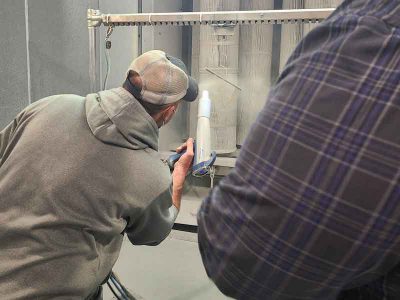When talking about the costs associated with coating applications, especially if it is powder coatings, it is a constant goal to lower your applied costs.
Improving first-pass powder coating transfer efficiency is THE critical factor to increasing coverage per square foot coated.
This is true even if your powder coating system reclaims powder.
The claims of 95% to 99% transfer efficiency with reclaim systems is not realistic in production environments. In reality typical transfer efficiencies are 50% with spray to waste coating systems and 65% to 85% with reclaim systems.
Why First-Pass Transfer Efficiency is important

Simply put, the higher percentage of first pass powder that stays with the part the lower percentage that is either wasted, in spray to waste, or must be reclaimed.
The assertion that “because we reclaim our powder we do not need to be so concerned about first pass transfer efficiency” is wrong. Reclaimed powder is always damaged to some extent. The size of powder particles is reduced, and the particles do not recharge as well. Reclaimed powder is added back to the virgin powder which dilutes its effectiveness and consequently reduces the transfer efficiency.
Another major consideration is quality of finish.
Virgin powder will always provide a higher quality more consistent finish than a powder blend of virgin and reclaimed powder.
Factors Affecting Transfer Efficiency
• type of powder
• size weight and shape of item being coated
• grounding, distance of gun from part
• air flow of the spray booth
• pressure of the powder delivery air
Compressed Air Variation
Another critical factor affecting transfer efficiency is compressed air. The changing temperature and chemical makeup of compressed air effects its ability to charge and carry the powder to the substrate.
When these effects are noticed, the typical solution is to increase the atomizing air pressure and increase the percent of powder setting. Once the atomizing air and percent of powder are turned up, they are rarely turned down.
When the atomizing air pressure and powder setting percentage are turned up first pass transfer efficiency goes down. Conditioning of the compressed air with filters and refrigerated dryers is important but does not eliminate the problem. Many times, these items are too far away from the spray booth.
However, the oven is generally not far from the spray booth. The heat from the oven, usually located immediately after the spray booth, will increase the temperature of the compressed air line coming to the spray booth.
New Technology to check out to help boost your transfer efficiency (CDT)
Maximum transfer efficiency occurs when powder has time to be charged and more time to be around the substrate. But achieving the lowest atomizing pressure and powder percent is difficult to maintain with the constantly changing temperature and formulation of compressed air.

A relatively new technology from Polifluid (Coating Delivery Technology, LLC) has eliminated this issue by converting the compressed air to a high percentage of nitrogen which is anhydrous and inert.
Additionally, Polifluid maintains the powder at optimal temperature and provides the ability to add a positive or negative charge to minimize rebound and maximize attraction to the substrate.
According to CDT, This technology provides the ability to constantly charge and deliver powder at lower pressures than compressed air.
Learn More about Improving Your First-Pass Powder Coating Transfer Efficiency
For a more detailed explanation of this topic, here are a couple of articles that expand on the topic:
1. How to boost first-pass transfer efficiency in powder coating
by Frank Mohar, The Fabricator
2. The Importance of Transfer Efficiency in Detail – PCO article
3. Application Variable for Powder Coating Systems – The purpose of this paper is to provide an overview of powder application technology and variables that affect first-pass transfer efficiency. (pdf)
By Ken Kreeger, Powder Systems Group, Nordson Corporation
pcoadmin










